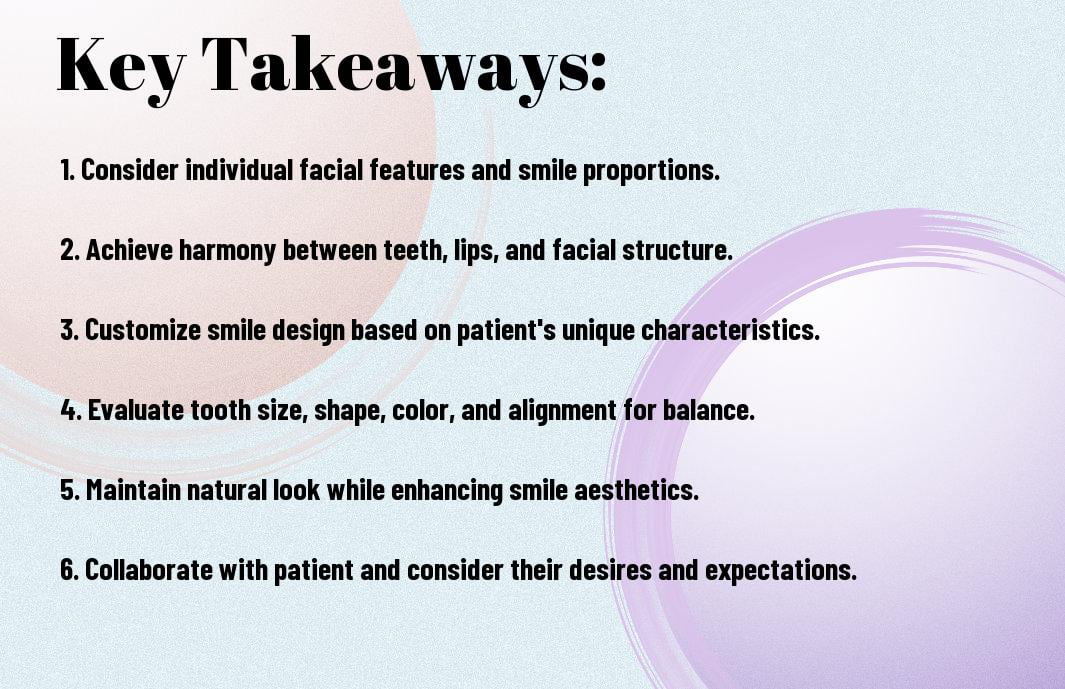Just imagine the impact a harmonious smile can have on overall facial aesthetics. In this informative blog post, we will explore the crucial principles of smile design that help achieve balance and harmony in facial aesthetics. From understanding the golden ratios to considering individual facial features, you will discover how to create a smile that not only looks beautiful but also enhances the overall balance of the face. Let’s examine into the fascinating world of smile design and unlock the secrets to creating stunning smiles that radiate confidence and beauty.
Key Takeaways:
- Smile Design Principles: The article emphasizes the importance of understanding and applying smile design principles to achieve harmony and balance in facial aesthetics.
- Facial Aesthetics: Professionals in the field need to consider not only the teeth but also the overall facial features to create a natural and balanced smile that complements the individual’s unique attributes.
- Harmony and Balance: Achieving harmony and balance in smile design requires a comprehensive approach that integrates dental and facial aesthetics to enhance the overall appearance of the patient.
The Fundamentals of Smile Design
The Importance of Harmony and Balance
Smile design is not just about creating a beautiful smile; it’s about achieving harmony and balance in facial aesthetics. Your smile is a crucial aspect of your overall appearance, and it plays a significant role in how others perceive you. When your smile is in harmony with your facial features, it enhances your beauty and boosts your confidence.
Key Elements of Facial Aesthetics
An necessary aspect of smile design is understanding the key elements of facial aesthetics. Your smile should complement your facial features, such as the shape of your face, lips, and eyes. An experienced professional will consider these factors to create a smile that looks natural and balanced.
For instance, the size and shape of your teeth should be in proportion to your face. If your teeth are too large or too small, it can throw off the symmetry of your smile and detract from your overall appearance. By carefully analyzing your facial features, a skilled smile designer can create a personalized treatment plan to achieve the perfect balance and harmony in your smile.
Principles of Smile Analysis
Clearly, achieving a harmonious smile involves a thorough analysis of various factors contributing to facial aesthetics. By understanding the principles of smile analysis, you can create a smile that complements the overall facial features and enhances your patient’s appearance.
Evaluating Facial Proportions
Principles of evaluating facial proportions play a crucial role in smile design. You must consider the relationship between nose length, chin prominence, and lip position to determine the ideal proportions for your patient’s smile.
Assessing Tooth Shape and Size
Principles for assessing tooth shape and size involve analyzing the symmetry and proportion of the teeth to ensure a balanced smile. You need to evaluate factors such as tooth length, width, and shape to create a smile that looks natural and complements the patient’s facial aesthetics.
Plus, understanding the impact of tooth size and shape on smile design allows you to customize treatment plans that address individual patient needs. By considering these principles, you can achieve a smile that not only enhances aesthetics but also improves overall facial harmony.
Considering Lip and Gum Contours
For achieving a harmonious smile, you must consider the contours of the lips and gums. These elements play a significant role in framing the teeth and influencing the overall symmetry of the smile.
To enhance your understanding of smile design principles, it is necessary to analyze lip and gum contours in relation to tooth display and facial proportions. By paying attention to these details, you can create a smile that is not only aesthetically pleasing but also in harmony with your patient’s facial features.
The Role of Symmetry in Smile Design
Defining Symmetry in Facial Aesthetics
All faces have some degree of asymmetry, but achieving facial symmetry in smile design involves creating harmony and balance between the various components of the face. Facial symmetry is not about perfect mirror imaging but about achieving a pleasing and balanced overall appearance. In smile design, symmetry plays a crucial role in enhancing facial aesthetics and creating a natural-looking smile.
Achieving Balance through Symmetry
Any deviations from facial symmetry can impact the overall harmony and balance of a smile. By carefully assessing facial structures and features, you can tailor your smile design to correct asymmetries and create a more balanced and aesthetically pleasing smile. Adjusting the shape and size of teeth, aligning dental midlines, and harmonizing dental proportions are key strategies in achieving facial symmetry and balance in smile design.
Plus, incorporating facial symmetry principles in smile design can help you customize treatments to suit each individual’s unique facial features, enhancing the overall attractiveness and natural appearance of the smile.
Asymmetry: When Imperfection is Perfect
To embrace the beauty of nature and avoid an overly artificial look, sometimes strategic asymmetry can be used to enhance smile design. Imperfections such as slight variations in tooth size or positioning can add character and uniqueness to a smile. By understanding when asymmetry can be beneficial, you can create a smile that is not only aesthetically pleasing but also natural and authentic.
Achieving the ideal balance between symmetry and asymmetry in smile design requires a keen eye for detail and an understanding of how these principles can be used to create a harmonious and balanced smile that complements the natural features of the face.
Color and Texture in Smile Design
The Impact of Tooth Color on Smile Aesthetics
Keep in mind that tooth color plays a critical role in smile aesthetics. When designing a smile, it’s necessary to consider the shade of the teeth in relation to the rest of the facial features. The color of the teeth should complement the skin tone, eye color, and even hair color to create a harmonious and balanced overall appearance.
Texture and Surface Characteristics
Texture, along with color, is an important aspect of smile design. The surface characteristics of the teeth, such as sheen, translucency, and texture, can greatly impact the overall look of a smile. Pay close attention to these details when designing a smile to ensure a natural and aesthetically pleasing result.
Texture is a subtle yet crucial element in smile design. The way light interacts with the surface of the teeth can significantly influence the overall appearance of a smile.
Balancing Color and Texture for Harmony
Color and texture must be carefully balanced to achieve harmony in smile design. The color of the teeth should be in harmony with the texture and surface characteristics to create a natural and beautiful smile. Too much contrast between color and texture can lead to an unnatural look, while too little contrast can result in a bland appearance.
An understanding of how color and texture interact in smile design is necessary for creating aesthetically pleasing results. By skillfully balancing these elements, you can achieve a smile that enhances the overall facial aesthetics and brings harmony to the features.
The interplay between color and texture is crucial in creating a balanced and harmonious smile design. By carefully considering how these elements work together, you can achieve a stunning result that enhances the natural beauty of the face.
Smile Design and Facial Expression
The Connection between Smile and Facial Expression
Not only is your smile a key element of facial aesthetics, but it also plays a crucial role in conveying your emotions and expressions to others. Your smile is a powerful tool that can communicate joy, warmth, confidence, and approachability without saying a word. In fact, research has shown that the mere act of smiling can have a positive effect on your mood and those around you.
Designing Smiles that Enhance Emotional Expression
To design a smile that complements your unique facial expressions, it’s crucial to consider how different features such as lip curvature, tooth shape, and gingival display can impact your overall emotional appeal. A well-designed smile can enhance your ability to express a wide range of emotions effectively, from a genuine, warm grin to a subtle, polite smile that conveys diplomacy and restraint.
Connection between your smile and facial expression is intricate, with each element influencing the other. By optimizing your smile design to harmonize with your facial expressions, you can create a more balanced and aesthetically pleasing overall look that is in sync with your emotions.
Considering Age and Personality in Smile Design
That youthful, vibrant smile you had in your 20s might not necessarily suit you in your 40s. Similarly, a smile that exudes charisma and confidence may not be suitable for someone with a more reserved personality. When designing a smile, it’s crucial to take into account factors such as age and personality to ensure that your smile not only enhances your facial aesthetics but also aligns with your personal characteristics.
A well-designed smile should not only enhance your facial features but also reflect your unique personality traits. By considering age and personality in your smile design, you can create a harmonious and balanced look that not only boosts your confidence but also authentically represents who you are.
Advanced Smile Design Techniques
Once again, in advanced smile design techniques, there are several innovative approaches that can help you achieve optimal results for your patients. Here are some key techniques to consider:
- Using Digital Imaging for Smile Simulation
Simulation
Benefit: Allows you to create a digital representation of the desired smile before any treatment begins. How to Implement: Use specialized software to manipulate images of the patient’s current smile and preview potential outcomes. By utilizing digital imaging, you can provide your patients with a visual representation of the proposed changes to their smile. This technology enhances communication and helps them make informed decisions about their treatment plan.
- Customizing Smile Design for Unique Facial Features
Smile
Customizing the smile design to complement the unique facial features of each individual is important for achieving natural-looking results. Factors such as lip shape, facial symmetry, and overall facial proportions should be taken into account when designing the perfect smile.
- Integrating Smile Design with Overall Facial Aesthetics
Imaging
Integrating smile design with overall facial aesthetics involves assessing how the smile fits within the context of the entire face. Considerations such as the patient’s jawline, chin prominence, and the position of the teeth in relation to the lips all play a role in creating a harmonious facial appearance.
Plus, when customizing the smile design for unique facial features and integrating it with overall facial aesthetics, you can elevate your practice to new heights of precision and artistry. Your patients will appreciate the personalized approach that considers their individual characteristics, resulting in smiles that not only look beautiful but also feel uniquely their own.
To wrap up
On the whole, understanding the principles of smile design is crucial in achieving harmony and balance in facial aesthetics. By considering factors such as facial symmetry, tooth shape, color, and alignment, you can create beautiful smiles that enhance your patients’ overall appearance. Remember to take a holistic approach, considering the unique features of each individual to create personalized and natural-looking results.
FAQ
Q: What are the key principles of Smile Design?
A: Smile Design principles focus on achieving harmony and balance in facial aesthetics through considerations such as tooth proportion, symmetry, and alignment.
Q: How does facial aesthetics impact Smile Design?
A: Facial aesthetics play a crucial role in Smile Design as they influence factors like lip support, smile line, and overall facial symmetry, all of which contribute to a balanced and aesthetically pleasing smile.
Q: What are some common techniques used in achieving Smile Design harmony?
A: Techniques such as digital smile design, mock-up procedures, and smile analysis tools are commonly employed by dental professionals to plan and execute Smile Design treatments effectively, ensuring optimal harmony and balance in facial aesthetics.







